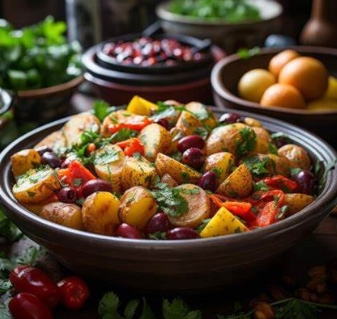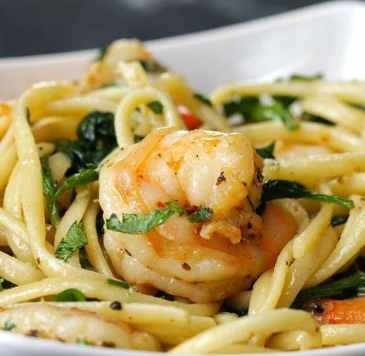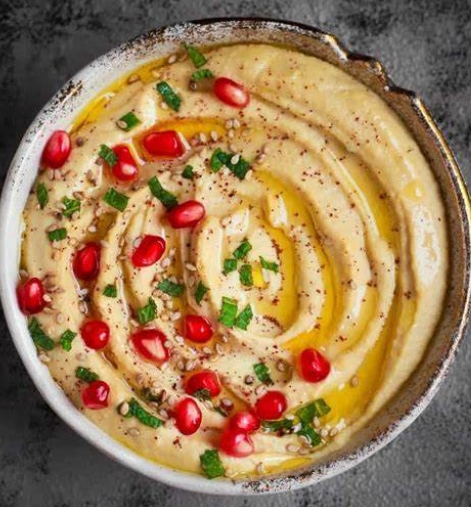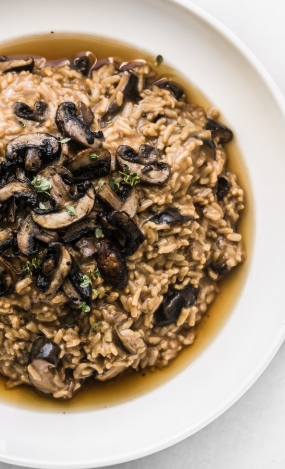Tagine, a traditional Moroccan dish, is a rich and flavorful stew that has been enjoyed in Morocco for centuries. Named after the unique clay pot in which it is cooked, the tagine is a quintessential example of Moroccan cuisine, blending tender meat, vegetables, dried fruits, and a variety of spices into one harmonious and aromatic dish. It’s a meal that brings people together, often shared in large family gatherings, where everyone scoops from the communal pot.
The key to a perfect tagine lies in its slow-cooking process. The tagine pot, with its conical lid, traps moisture and allows the dish to cook slowly, resulting in incredibly tender meat and perfectly infused flavors. While the cooking method and pot are essential, the true magic of tagine lies in the combination of spices and ingredients.
Typically, a tagine is made with lamb, chicken, or beef, although variations can include seafood or even vegetarian options. The meat is first browned in the pot, and then simmered with a mixture of onions, garlic, and an array of spices such as cumin, coriander, ginger, saffron, turmeric, and cinnamon. These spices create the unmistakable warm, earthy, and aromatic flavors that are a hallmark of Moroccan cooking.
In addition to the meat and spices, tagine often includes dried fruits like apricots, raisins, or dates, which add a subtle sweetness that balances the savory richness of the dish. Nuts, such as almonds, are also commonly used to add crunch and texture. Fresh herbs like cilantro and parsley are sprinkled over the top before serving, bringing a fresh and bright note to the dish.
One of the most popular variations of tagine is chicken with preserved lemons and olives, a combination of tangy preserved lemons and briny olives that perfectly complement the rich chicken and aromatic spices. This version is particularly famous for its ability to balance salty, sour, and sweet flavors in one pot, creating a deeply satisfying and complex dish.
Cooking tagine at home requires patience, but the results are well worth the effort. The slow-cooking process allows the flavors to meld together, and the meat becomes so tender that it practically falls off the bone. The dish is traditionally served with couscous or khobz (Moroccan flatbread), which help to soak up the delicious sauce.
Tagine is not only a dish for family meals but also a symbol of Moroccan hospitality. In Moroccan culture, food plays a central role in bringing people together, and tagine is often served in large, communal dishes for everyone to share. It’s common to find tagine served at special occasions like weddings, holidays, and celebrations, where the hearty, flavorful stew is enjoyed by family and friends.
The versatility of tagine also means it can be adapted to suit different tastes and dietary preferences. Vegetarian tagines, which are made with a variety of root vegetables, chickpeas, and dried fruits, offer a delightful alternative for those who prefer plant-based meals. The spices in the vegetarian version remain the same, creating a flavorful and aromatic dish that is both hearty and satisfying.
Moroccan cuisine is known for its use of bold and diverse flavors, and tagine is one of the best representations of this culinary tradition. The dish is a fusion of influences from Arab, Berber, and Mediterranean cultures, with each bringing its own unique flavors and techniques to the table. The result is a dish that is both rich in history and packed with delicious flavors.
Today, tagine can be found in Moroccan restaurants around the world, often served alongside other traditional dishes like harira (a lentil and tomato soup) and mechoui (slow-roasted lamb). However, nothing compares to the experience of enjoying a homemade tagine, served straight from the pot, where the aromas of spices and simmering meat fill the room and invite everyone to gather around.
In Morocco, tagine is more than just a meal—it’s an experience. The slow-cooked stew, filled with rich flavors and textures, represents the heart of Moroccan hospitality. Whether it’s a simple weekday dinner or a grand feast, tagine is a dish that continues to delight and bring people together, creating memories that last long after the last bite.





